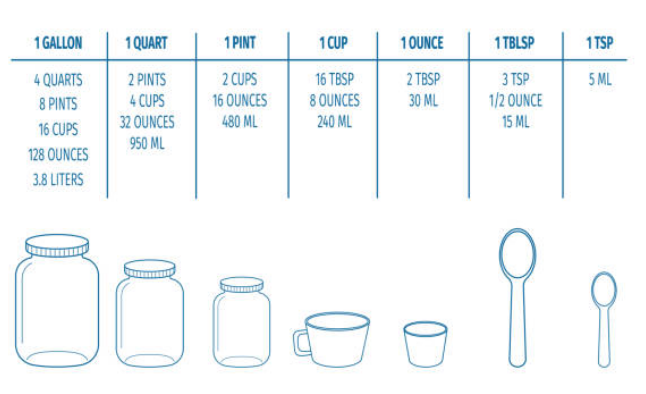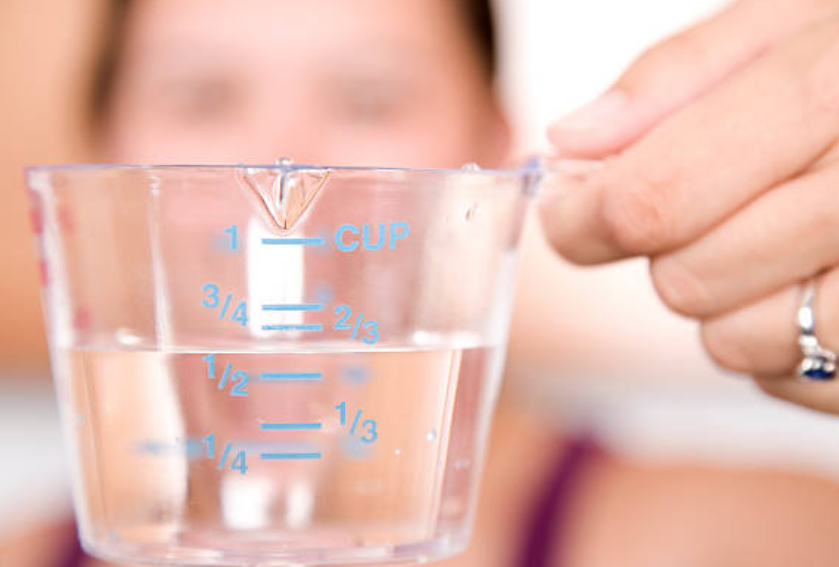Dive into the heart of culinary precision, where a sprinkle too much or too little could make all the difference between a masterpiece and a mishap. Picture this: you’re following a beloved family recipe, only to find yourself stuck at a crossroads when it comes to converting ounces to milliliters or cups to pints. Fear not, for in the realm of cooking, knowledge truly is power. In our culinary journey, one tool reigns supreme – the liquid measurement conversion chart. Imagine unlocking the secrets to seamless conversions, effortlessly gliding between metric and imperial systems with the finesse of a seasoned chef. This essential guide is not merely a list of numbers; it’s a gateway to culinary liberation. Say goodbye to kitchen guesswork and hello to precision as we unravel the enigmatic world of liquid measurements. Join us on a quest to demystify the art of converting liquids, where every drop counts and every measurement matters – because in the realm of gastronomy, precision is the key to unlocking a world of flavors.

 Understanding the Basics: Ounces, Milliliters, Cups, and Pints
Understanding the Basics: Ounces, Milliliters, Cups, and Pints
Before we dive into the intricacies of liquid measurement conversions, let’s start by understanding the basics. In the culinary world, ounces, milliliters, cups, and pints are commonly used units of measurement for liquids.
An ounce is a unit of weight or volume that is widely used in both the metric and imperial systems. In the metric system, 1 ounce is equivalent to approximately 29.57 milliliters (ml), while in the imperial system, it is equal to approximately 28.35 grams (g).
Milliliters (ml) are a unit of volume primarily used in the metric system. They are often used to measure smaller quantities of liquids such as water or milk. One milliliter is equivalent to one cubic centimeter (cc) or one thousandth of a liter.
Cups are a common unit of measurement in cooking and baking. In the United States, one cup is equal to 8 fluid ounces (fl oz) or approximately 237 milliliters (ml). However, it’s important to note that cup measurements can vary depending on the country or region.
Pints are another unit of liquid measurement commonly used in cooking. In the United States, one pint is equal to 16 fluid ounces or approximately 473 milliliters. It’s worth mentioning that there are different types of pints – liquid pints and dry pints – so be sure to use the appropriate conversion factor based on your specific needs.
How do you convert cups to grams?
Converting cups to grams can be a bit tricky since different ingredients have different densities. However, there are some general guidelines you can follow:
– For dry ingredients such as flour or sugar, 1 cup is approximately equal to 120-130 grams.
– For liquids such as water or milk, 1 cup is equivalent to 240 milliliters, which is also equal to 240 grams.
Keep in mind that these are rough estimates and may vary depending on the specific ingredient and its moisture content. It’s always best to consult a reliable conversion chart or use a kitchen scale for more accurate measurements.
How do you convert 1/3 of a cup into ounces?
To convert 1/3 of a cup into ounces, you can use the following conversion factor:
– Since there are 8 fluid ounces in a cup, divide 8 by 3 to get approximately 2.67 fluid ounces.
It’s important to note that this conversion applies specifically to fluid ounces. If you’re working with dry ingredients, the weight may be different due to variations in density.
Since a cup is 8 ounces (237 ml/227 g), why do some products say that a cup is 4 ounces (118 ml/113 g)?
The discrepancy between the standard measurement of a cup (8 ounces) and the smaller measurement (4 ounces) often arises from differences in regional or industry-specific conventions. Some products may use smaller cups as their standard unit of measurement for convenience or historical reasons.
If you come across a recipe or product that uses a different cup measurement than what you’re accustomed to, it’s best to refer to the specific instructions provided. Alternatively, you can convert the given measurements using an appropriate conversion chart or calculator.
How much is 30 mL in tablespoons?
In most cases, one tablespoon is equivalent to approximately 15 milliliters (ml). Therefore, 30 milliliters would be equivalent to 2 tablespoons.
However, it’s important to note that tablespoon measurements can vary slightly depending on the country or region. For precise conversions, it’s always best to consult a reliable conversion chart or use a measuring spoon specifically marked with tablespoon measurements.
How do I measure 1/8 cup when I don’t have a 1/8 cup?
If you find yourself in need of measuring 1/8 cup but don’t have a specific measuring cup for that quantity, there are a few alternative methods you can try:
– Use a 1/4 cup and fill it halfway.- Use a tablespoon and measure out two tablespoons (which is equivalent to 1/8 cup).
Remember to level off the measurement for accuracy. It’s always helpful to have a variety of measuring tools on hand to ensure precise measurements in your cooking endeavors.
Is there a simple way to transfer American measuring units into metric ones, especially for kitchen purposes?
Absolutely! Converting American measuring units into metric ones can be made simpler by using conversion charts or calculators specifically designed for kitchen purposes. These tools allow you to seamlessly convert between ounces, cups, grams, milliliters, and other common units of measurement.
Additionally, many modern kitchen scales come with built-in conversion features that allow you to switch between different measurement systems at the touch of a button. Investing in one of these versatile scales can greatly simplify your cooking process and ensure accurate measurements every time.
What’s the best way to measure 1/6 cup or 40 ml?
If you need to measure out 1/6 cup or approximately 40 milliliters, you can use the following methods:
– Use a 1/4 cup and fill it about two-thirds full.- Use a tablespoon and measure out slightly less than three tablespoons (which is approximately 1/6 cup or 40 milliliters).
Remember to level off the measurement for accuracy. Having a variety of measuring tools at your disposal will make it easier to measure out specific quantities in your recipes.
Could I measure out 1 ounce of water as a substitution for fluid ounces if I don’t have a fluid ounce measuring cup?
If you find yourself in need of measuring fluid ounces but don’t have a specific measuring cup, you can use an alternative method. Since 1 fluid ounce is equivalent to approximately 29.57 milliliters, you can measure out approximately 30 milliliters of water as a substitute for 1 fluid ounce.
However, it’s important to note that this substitution may not be entirely accurate for all liquids, especially those with different densities or viscosities. For precise measurements, it’s always best to use the appropriate measuring tools or consult a reliable conversion chart.
How can cup measurements be converted to metric without changing the recipe’s proportions?
To convert cup measurements to metric without altering the recipe’s proportions, you’ll need to determine the specific conversion factors for each ingredient. Here are some common conversion factors:
– For liquids such as water or milk:- 1 cup = approximately 237 milliliters (ml)- 1/2 cup = approximately 118 ml- 1/4 cup = approximately 59 ml
– For dry ingredients such as flour or sugar:- The weight may vary depending on the ingredient and its density. It’s best to consult a reliable conversion chart or use a kitchen scale for accurate measurements.
By using these conversion factors, you can easily convert cup measurements to metric without compromising the recipe’s proportions. Remember to adjust other ingredients accordingly if necessary.
Can you recommend me a chart that has the different SI unit conversions for both Imperial and metric?
There are numerous conversion charts available online that provide comprehensive lists of SI unit conversions for both the imperial and metric systems. One highly recommended resource is the National Institute of Standards and Technology (NIST) website, which offers an extensive collection of conversion tables and calculators.
Additionally, many cooking websites and apps also provide user-friendly conversion charts specifically tailored for culinary purposes. These charts often include common ingredients and their respective conversions between different units of measurement.
How can I tell how many ounces are in 1/4 cup?
To determine how many ounces are in 1/4 cup, you can use the following conversion factor:
– Since there are 8 fluid ounces in a cup, divide 8 by 4 to get 2 fluid ounces. Therefore, there are approximately 2 fluid ounces in 1/4 cup.
It’s important to note that this conversion applies specifically to fluid ounces. If you’re working with dry ingredients, the weight may be different due to variations in density.
How do I convert metric measurements for recipes into US cup measurements? For example, how much is 250g flour in US measurements? Or 375ml stock in US cups?
To convert metric measurements into US cup measurements, you’ll need to refer to specific conversion factors for each ingredient. Here are some common conversions:
– For flour:- Approximately 125 grams (g) of flour is equivalent to 1 cup.- Therefore, 250 grams of flour would be approximately 2 cups.
– For stock or other liquids:- Approximately 240 milliliters (ml) or 1 cup is equivalent to 8 fluid ounces.- Therefore, 375 milliliters of stock would be approximately 1.5 cups.
Keep in mind that these are rough estimates and may vary depending on the specific ingredient and its density. It’s always best to consult a reliable conversion chart or use a kitchen scale for more accurate measurements.
Are liquid ingredients measured the same way as dry ingredients?
No, liquid ingredients are typically measured differently than dry ingredients. Liquid measurements are usually done using measuring cups or spoons specifically designed for liquids, while dry ingredients are measured using measuring cups or spoons designed for dry goods.
When measuring liquid ingredients, it’s important to use a clear measuring cup with markings for fluid ounces, milliliters, or cups. Fill the liquid up to the appropriate marking and ensure that the measurement is level by checking at eye level.
Dry ingredients, on the other hand, should be measured using dry measuring cups or spoons. These have flat tops that allow you to level off the excess with a straight edge for precise measurements.
What measurements are used in metric for teaspoons and tablespoons?
In the metric system, teaspoons (tsp) and tablespoons (tbsp) are commonly used units of measurement for small quantities of ingredients. Here are their approximate equivalents:
– Teaspoon (tsp):- Approximately 5 milliliters (ml) or one-fifth of a tablespoon.- Approximately one-third of a fluid ounce.
– Tablespoon (tbsp):- Approximately 15 milliliters (ml) or three teaspoons.- Approximately one-half of a fluid ounce.
It’s important to note that these measurements may vary slightly depending on the country or region. For precise conversions, it’s always best to consult a reliable conversion chart or use measuring spoons specifically marked with teaspoon and tablespoon measurements.
How do I remember different units of measurements with conversion?
Remembering different units of measurement and their conversions can be challenging, but there are a few strategies that can help:
– Create mnemonic devices: Come up with catchy phrases or acronyms that help you remember specific conversions. For example, “A pint’s a pound the world around” can remind you that 1 pint is approximately equal to 1 pound in weight.
– Use visual aids: Draw diagrams or charts that visually represent the relationships between different units of measurement. This can make it easier to visualize and understand the conversions.
– Practice regularly: The more you work with different units of measurement and practice converting between them, the more familiar they will become. Over time, you’ll develop a better understanding and memory for these conversions.
– Utilize technology: There are numerous conversion apps and websites available that can quickly provide you with accurate conversions for various units of measurement. These tools can be especially helpful when dealing with less common or complex conversions.
The Significance of Accurate Measurements in Cooking
Accurate measurements play a crucial role in cooking, as they directly impact the outcome of your culinary creations. Whether you’re baking delicate pastries or simmering savory sauces, precise measurements ensure consistency and balance in flavors and textures.
Using too much or too little of an ingredient can significantly alter the taste, texture, and overall quality of a dish. For example, adding too much flour to a cake batter can result in a dense and dry cake, while using too little salt in a savory dish can leave it bland and lackluster.
Accurate measurements also help maintain the integrity of recipes. When you follow a recipe precisely, you’re able to recreate the intended flavors and textures envisioned by the recipe creator. This is especially important when cooking traditional or cultural dishes that have been passed down through generations.
Furthermore, precise measurements are essential for achieving consistent results. If you’re developing your own recipes or experimenting with variations of existing ones, accurate measurements allow you to replicate successful outcomes and make necessary adjustments for future iterations.
In conclusion, mastering liquid measurement conversions is an invaluable skill for any aspiring cook or seasoned chef. By understanding the basics of ounces, milliliters, cups, and pints, as well as utilizing conversion charts and tools when needed, you can confidently navigate between different measurement systems without compromising the accuracy of your recipes. So go forth with your newfound knowledge and unlock a world of culinary possibilities!

